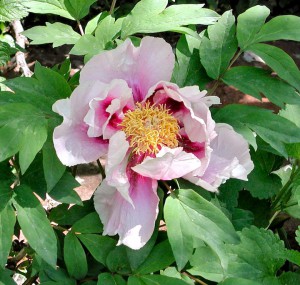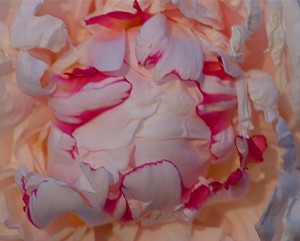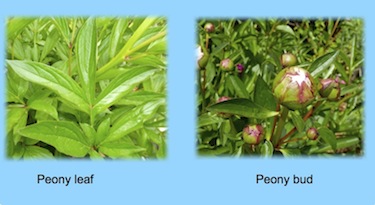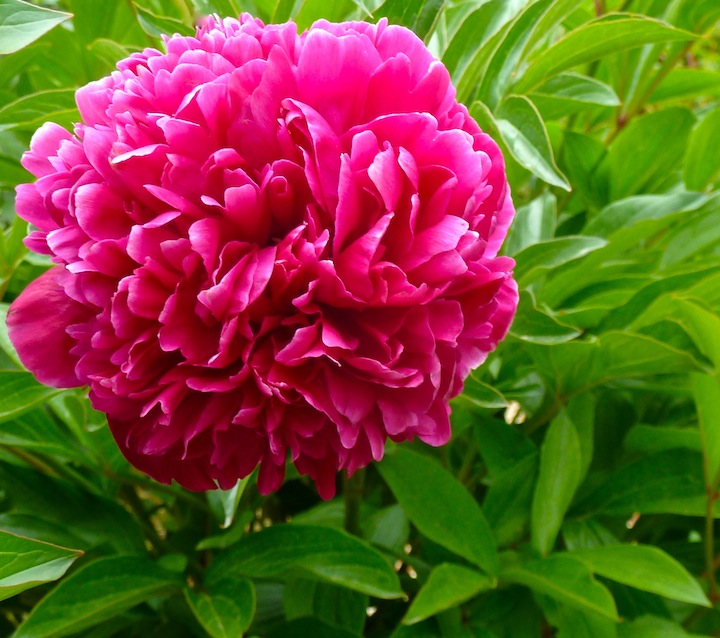 Scientific Genus name: Paeonia
Scientific Genus name: Paeonia
Plant Family: Paeoniaceae
Common name: Peony
Text and photos by Janice Tucker
Peonies are among those beautiful but ephemeral flowers that grace our gardens in late spring or early summer. Lasting only a few short weeks, their blossoms are gone long before most of us are ready to bid them farewell until the next year. But their delicate and tantalizing scent and large, colorful flowers convince most gardeners that their short time to shine in a garden is preferable to having no Peonies at all.

This long-lived, deep-rooted, flowering perennial is native to Asia, southern Europe and western North America.
Paeonia is the only genus in the Paeoniaceae plant family. The number of species of the Paeonia genus is estimated to range between 20 to 40 species plus numerous cultivars. There are sure to be some lovely specimens on display at this year’s Santa Fe Botanical Garden annual Garden Tour on Sunday, June 3 and Sunday, June 10.
The two distinct Peony growth habits are the herbaceous perennial, which reaches a height ranging between 1.5 to 5 feet and the tree Peony that grows between 5 to 10 feet. The green, compound leaves are so deeply lobed that at first glance they appear to be single and lance-shaped. In late spring or early summer, large, rounded buds cover the plant to burst into even larger, puffy, colorful, fragrant flowers. There is also the single Peony flower that resembles an oversized, old- fashioned rose. Colors vary in whites, yellows, pinks, and red, with some cultivars coming in bi-colors. The pink and white bi-color Peony may cause the gardener to suddenly develop a craving for a tasty dish of strawberries and cream.

 Peonies need the cold of winter to flower. Herbaceous Peonies will die back to the ground in the winter. Tree Peonies will lose their foliage but the woody stems remain during the dormant period. The tree Peony stems can appear to be lifeless in the winter, but do resist the urge to cut it back. If there is no hard freeze damage, the tree Peony will awaken from its winter dormancy to bloom again. Both types will embrace cold temperatures but the herbaceous species love the full sun more than the tree Peonies. Ants are attracted to the flowers’ nectar but do not harm the plant. To avoid bringing the ants into the house, be sure to lightly spray the flowers with water before using in arrangements.
Peonies need the cold of winter to flower. Herbaceous Peonies will die back to the ground in the winter. Tree Peonies will lose their foliage but the woody stems remain during the dormant period. The tree Peony stems can appear to be lifeless in the winter, but do resist the urge to cut it back. If there is no hard freeze damage, the tree Peony will awaken from its winter dormancy to bloom again. Both types will embrace cold temperatures but the herbaceous species love the full sun more than the tree Peonies. Ants are attracted to the flowers’ nectar but do not harm the plant. To avoid bringing the ants into the house, be sure to lightly spray the flowers with water before using in arrangements.
Autumn is the optimal time to plant Peonies and also to divide those that may have become crowded in a flowerbed. Spring planting is acceptable but the blooms may be delayed until the following year. Gardeners should be aware that Peonies, once established, do not like to be transplanted. Propagation by seed or root division is best for herbaceous Peonies. Tree Peonies are more commonly propagated from root grafting. Placement on a northern exposure, protected from the wind will help to encourage flowering. Peonies need well-drained soil with a pH range between 6.0 to 7.0 and normal water requirements. Go lightly on the fertilizer since too much nitrogen will prevent blooming….and who would want to prevent this plant from producing its beautiful flowers?
The first mention of a Peony dates back thousands of years. The Chinese claim it as a symbol of riches and honor and the flower’s image is often seen in its country’s tapestries and artwork. The Peony is the state flower of Indiana and commemorates the twelfth wedding anniversary. In the language of flowers the Peony stands for romance, prosperity and a happy marriage. But in some Asian cultures, men will sport a Peony tattoo that announces an attitude of bravado and a total disregard for danger.
The scientific name of Paeonia was given to honor Paeon, a physician to the gods in Greek mythology. There are several versions of the myth but the one that honors this lovely flower the most claims that Paeon was a student of Asclepius, the Greek god of medicine and healing (for whom the Asclepias genus is named). As Paeon became well known and more famous for his skills, Asclepius became obsessed with an intense, jealous anger of his former pupil. Zeus stepped in to save Paeon from certain death at the hand of Asclepius by turning Paeon into the peony flower.
There are certainly worse ways to spend eternity than as a cherished and beautiful Peony.



